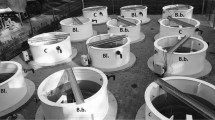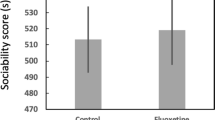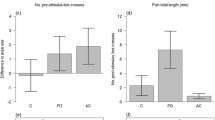Abstract
Aquatic ecosystems are major sinks for pollutants which can have adverse effects on biodiversity. Thus, it is important to understand the nature of pollution-induced change in aquatic ecosystems. We show that brown bullheads (Ameiurus nebulosus) may have evolved in response to chronic pollution exposure. We collected adults from the Detroit River (polluted site) and Belle River (control site). Both adults and common-garden raised juveniles were tested for aggression, locomotion, and escape response using consecutive unchallenged (clean) and challenged (polluted) trials. Detroit River fish were more aggressive than Belle River fish when challenged. Furthermore, Belle River fish showed increased locomotion when exposed to pollutants, whereas Detroit River fish were unaffected. The consistent difference in adult and juvenile behaviour across trials suggests a genetic response to pollution. Escape response on the other hand, showed inter-population differences, but no consistency between adults and juveniles, indicating that this behaviour is influenced by non-genetic factors. We discuss our data with respect to the potential adaptation of populations to pollution and the implications for prioritizing remediation efforts.



Similar content being viewed by others
References
Allin CJ, Wilson RW (2000) Effects of pre-acclimation to aluminium on the physiological and swimming behaviour of juvenile rainbow trout (Oncorhynchus mykiss) during a pulsed exposure. Aquat Toxicol 51:213–224
Almeida JA, Barreto RE, Novelli ELB, Castro FJ, Moron SE (2009) Oxidative stress biomarkers in fish exposed to aquatic cadmium contamination. Neotrop Ichthyol 7:103–108
Arcand-Hoy LD, Metcalfe CD (1999) Biomarkers of exposure of brown bullheads (Ameiurus nebulosus) to contaminants in the lower Great Lakes, North America. Environ Toxicol Chem 18:740–749
Baatrup E, Bayley M (1993) Quantative analysis of spider locomotion employing computer-automated video tracking. Physiol Behav 54:83–90
Baccarelli A, Bollati V (2009) Epigenetics and environmental chemicals. Curr Opin Pediatr 21:243–251
Barrett RDH, Schulter D (2007) Adaptation from standing genetic variation. Trends Ecol Evol 23:38–44
Bayley M, Baatrup E, Bjerregaard P (1997) Woodlouse locomotor behaviour in the assessment of clean and contaminated field sites. Environ Toxicol Chem 16:2309–2314
Beattie JH, Pascoe D (1978) Cadmium uptake by rainbow trout, Salmo gairdneri eggs and alevins. J Fish Biol 13:631–637
Bell AM (2001) Effects of an endocrine disrupter on courtship and aggressive behaviour of male three-spined stickleback, Gastrerosteus aculeatus. Anim Behav 62:775–780
Blumer LS (1985) Reproductive natural history of brown bullhead Ictalurus nebulosus in Michigan. Am Midl Nat 114:318–330
Cachot J, Law M, Pottier D, Peluhet L, Norris M, Budzinski H, Winn R (2007) Characterization of toxic effects of sediment-associated organic pollutants using the λ transgenic medaka. Environ Sci Technol 41:7830–7836
Chung KS (2001) Critical thermal maxima and acclimation rate of the tropical guppy Poecilla reticulata. Hydrobiologia 462:253–257
Darwin C (1859) The origin of species by means of natural selection. John Murray, London
Djomo JE, Garrigues P, Narbonne JF (1996) Uptake and depuration of polycyclic aromatic hydrocarbons from sediment by the zebrafish (Brachydanio rerio). Environ Toxicol Chem 15:1177–1181
Drouillard KG, Tomczak M, Reitsma S, Haffner GD (2006) A river-wide survey of polychlorinated biphenyls (PCBs), polycyclic aromatic hydrocarbons (PAHs), and selected organochlorine pesticide residues in sediments of the Detroit River—1999. J Great Lakes Res 32:209–226
Drummond RA, Russom CL (1990) Behavioural toxicity syndromes: a promising tool for assessing toxicity mechanisms in juvenile fathead minnows. Environ Toxicol Chem 9:37–46
Eranen JK (2008) Rapid evolution towards heavy metal resistance by mountain birch around two subarctic copper-nickel smelters. J Evol Biol 21:492–501
Fero K, Simon JL, Jourdie V, Moore PA (2007) Consequences of social dominance on crayfish resource use. Behaviour 144:61–82
Ficke AD, Myrick CA, Hansen LJ (2007) Potential impacts of global climate change on freshwater fisheries. Rev Fish Biol Fish 17:581–613
Fisher MA, Oleksiak MF (2007) Convergence and divergence in gene expression among natural populations exposed to pollution. BMC Genomics 8:108
Furlong ET, Carter DS, Hites RA (1988) Organic contaminants in the sediment from the Trenton Channel of the Detroit River, Michigan. J Great Lakes Res 14:489–501
Gardinali PR, Sericano JL, Wade TL (2004) Uptake and depuration of toxic halogenated aromatic hydrocarbons by the American oyster (Crassostrea virginica): a field study. Chemosphere 54:61–70
Grant PR, Grant BR (1995) Predicting microevolutionary responses to directional selection on heritable variation. Evolution 49:241–251
Gray MA, Teather KL, Metcalfe CD (1999) Reproductive success and behaviour of Japanese medaka (Oryzias latipes) exposed to 4-tert-octylphenol. Environ Toxicol Chem 18:2587–2594
Grue CE, Gardner SC, Gibert PL (2002) On the significance of pollutant-induced alterations in the behaviour of fish and wildlife. In: Dell’Omo G (ed) Behavioural ecotoxicology. Wiley, Chichester, pp 1–90
Hall AT, Oris JT (1991) Anthracene reduces reproductive potential and is maternally transferred during long-term exposure in fathead minnows. Aquat Toxicol 19:249–264
Hall JD, O’Connor K, Ranieri J (2006) Progress toward delisting a Great Lakes Area of Concern: the role of integrated research and monitoring in the Hamilton Harbour remedial action plan. Environ Monit Assess 113:227–243
Hammerschmidt CR, Wiener JG, Frazier BE, Rada RG (1999) Methylmercury content of eggs in yellow perch related to maternal exposure in four Wisconsin lakes. Environ Sci Technol 33:999–1003
Hedrick AV (2000) Crickets with extravagant mating songs compensate for predation risk with extra caution. Proc R Soc Lond B Biol Sci 267:671–675
Heidtke TM, Hartig J, Yu B (2002) Evaluating ecosystem results of PCB control measures within the Detroit River-western Lake Erie basin. Great Lakes National Program Office, U.S. Environmental Protection Agency, EPA-905-R-03-001, Chicago, IL
Hendry AP, Hensleigh JE, Reisenbichler RR (1998) Incubation temperature, developmental biology, and the divergence of sockeye salmon (Oncorhynchus nerka) within Lake Washington. Can J Fish Aquat Sci 55:1387–1394
Jaeger JW, Carlson IH, Porter WP (1999) Endocrine, immune, and behavioural effects of aldicarb (carbamate), atrazine (triazine) and nitrate (fertilizer) mixtures at groundwater concentrations. Toxicol Ind Health 15:133–151
Jones KC, Reynolds JD (1997) Effects of pollution on reproductive behaviour of fishes. Rev Fish Biol Fish 7:463–491
Kavitha P, Rao VJ (2007) Oxidative stress and locomotion behaviour response as biomarkers for assessing recovery status of mosquito fish, Gambusia affinis, after lethal effect of an organophosphate pesticide, monocrotophos. Pestic Biochem Physiol 87:182–188
Kortet R, Hedrick A (2007) Abehavioural syndrome in the field cricket Gryllus integer: intrasexual aggression is correlated with activity in a novel environment. Biol J Linn Soc 91:475–482
Kraemer LD, Campbell PGC, Hare L (2005) A field study examiming metal elimination in juvenile yellow perch (Perca flavescens). Aquat Toxicol 75:108–126
Leadley TA, Balch G, Metcalfe CD, Lazar R, Mazak E, Habowsky J, Haffner GD (1998) Chemical accumulation and toxicological stress in three brown bullhead (Ameiurus nebulosus) populations of the Detroit River, Michigan, USA. Environ Toxicol Chem 17:1756–1766
Maccubbin AE, Ersing N, Frank ME (1991) Mutagenicity of sediments from the Detroit River. J Great Lakes Res 17:314–321
Martin P, Bateson P (1993) Measuring behaviour: an introductory guide, 2nd edn. Cambridge University Press, Cambridge, UK
Meyer JN, Di Giulio RT (2003) Heritable adaptation and fitness costs in killifish (Fundulus heteroclitus) inhabiting a polluted estuary. Ecol Appl 13:490–503
Moss B (1998) Ecology of fresh waters: man and medium, past to future. Blackwell Science Ltd, Blackwell Publishing, Oxford, UK
Moyle PB, Leidy RA (1992) Loss of biodiversity in aquatic ecosystems: evidence from fish faunas. In: Fielder PL, Jain SK (eds) Conservation biology. Chapman and Hall, New York, pp 127–169
Nagy E, Murdoch P, Murdoch A, Thomas RL (1984) Hydrocarbons in the surficial sediments of Lakes St Clair, Erie, and Ontario. Environ Geol 6:31–37
Parma MJ, Campana M, Loteste A (2008) Uptake and elimination of chromium in Cnesterodon decemmaculatus; Pisces; Poeciliidae, after sub-chronic experimental exposure. Fresenius Environ Bull 17:293–297
Scott WB (1955) Freshwater fishes of Eastern Canada, 2nd edn. University of Toronto Press, Canada, p 72
Scott GR, Sloman KA (2004) The effects of environmental pollutants on complex fish behaviour: integrating behavioural and physiological indicators of toxicity. Aquat Toxicol 68:369–392
Serrano R, Blanes MA, Lopez FJ (2008) Maternal transfer of organochlorine compounds to oocytes in wild and farmed gilthead sea bream (Sparus aurata). Chemosphere 70:561–566
Sih A, Bell A, Johnson JC (2004) Behavioural syndromes: an ecological and evolutionary overview. Trends Ecol Evol 19:372–378
Steele CW (1985) Latent behavioural toxicity of copper to sea catfish, Arius felis, and sheepshead, Archosargus probatocephalus. J Fish Biol 27:643–654
Szalinska E, Drouillard KG, Fryer B, Haffner GD (2006) Distribution of heavy metals in sediments of the Detroit River. J Great Lakes Res 32:442–454
U.S. Environmental Protection Agency (2007) Detroit River-Western Lake Erie Basin Indicator Project: oil pollution of the Detroit and Rouge Rivers. http://www.epa.gov/med/grosseile_site/indicators/oilspills.html
Wang JS (1998) Accumulation and depuration of aqueous and dietary PCB (Aroclor 1254) by striped bass (Morone saxatilis). Bull Environ Contam Toxicol 60:104–111
Ward AJW, Duff AJ, Currie S (2006) The effects of the endocrine disrupter 4-nonylphenol on the behaviour of juvenile rainbow trout (Oncorhynchus mykiss). Can J Fish Aquat Sci 63:377–382
Wcislo WT (1989) Behavioural environments and evolutionary change. Annu Rev Ecol Syst 20:137–169
West-Eberhard MJ (1989) Phenotypic plasticity and the origins of diversity. Annu Rev Ecol Syst 20:249–278
West-Eberhard MJ (2003) Developmental plasticity and evolution. Oxford University Press, Oxford, UK, p 24
Wheeler A (1978) Ictalurus melas (Rafinesque, 1820) and I. nebulosus (LeSueur, 1819): the North American catfishes in Europe. J Fish Biol 12:435–439
Yang X, Baumann PC (2006) Biliary PAH metabolites and the hepatosomatic index of brown bullheads from Lake Erie tributaries. Ecol Indic 6:567–574
Acknowledgements
We thank T. Leadley, L. Soderberg, M. Farwell, C. Beneteau, L. Crawford, and T. Pitcher for their help in the field. We also thank S. Colborne, L. Crawford, M. Evans, S. Garner, T. Hain, D. Heath, J. Van Zwol, and two anonymous reviewers for their comments on the manuscript. This work was funded by an NSERC Strategic Project Grant and the University of Western Ontario.
Author information
Authors and Affiliations
Corresponding author
Rights and permissions
About this article
Cite this article
Breckels, R.D., Neff, B.D. Pollution-induced behavioural effects in the brown bullhead (Ameiurus nebulosus). Ecotoxicology 19, 1337–1346 (2010). https://doi.org/10.1007/s10646-010-0520-1
Accepted:
Published:
Issue Date:
DOI: https://doi.org/10.1007/s10646-010-0520-1




